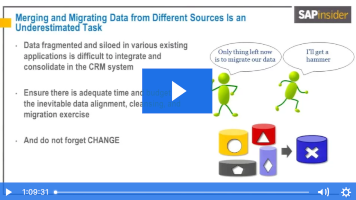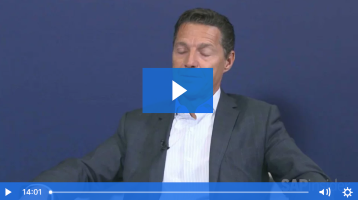There is a growing industry trend to measure the value of a product less by its functional lifespan and more by how it serves a company’s objectives in a 21st century marked by digitization, personalized goods and services, and an increasing focus on sustainability. Today, the customer matters more than ever, and meeting a customer’s evolving expectations significantly impacts how companies manufacture and deliver products.
Sealed Air has manufactured and distributed packaging supplies for more than 50 years. While Bubble Wrap helped launch the company and is its most iconic brand and product, Sealed Air later diversified to include food packaging as well as cleaning and sanitation solutions. Today, the company’s three business divisions are Product Care, Food Care, and Diversey Care.
Recognition that its customers’ needs were evolving was one of the main drivers for Sealed Air to embark on a customer engagement and commerce transformation journey. In a nutshell, the company realized that the value it provided customers wasn’t limited to or defined by the packaging supplies they purchased, but by how it helped customers engage with those supplies to drive greater value and enhance operational efficiency.
While Sealed Air recognized that it likely would have to implement new technology to accomplish this, the initiative was not driven by technology, per se. Rather, technology was viewed as a mechanism and platform to support the higher goal of realigning remodeled processes centered around enhanced customer satisfaction.
“As a company, our commercial transformation is a deliberate transition from being a traditional product and service offering into being a knowledge-based company that sells value,” says Naveen Kandasami, Sealed Air’s Global IT Director of Business Partnership and Customer Relationship Management (CRM) Strategy.
In practice, the changing conversations that Sealed Air sales and service associates were having with customers exemplified the basis for the transition. In its Product Care division, customers buying Bubble Wrap and other products weren’t necessarily interested in discussing quantity or routine product specifications, but in how those products could improve damage control and cost efficiency, for example. In Food Care, conversations centered on how to optimize freshness and expand shelf life. In Diversey Care, sales teams realized they weren’t selling cleaning and hygiene solutions so much as they were selling infection prevention and safety strategies. Throughout the business units, the discussions sales and service had with customers were more and more related to driving operational efficiency.
“Conversations have flipped from being a product-priced conversation to being about how to drive value for the customer, which is at the core of how we interact with our customers today,” says Kandasami. “To drive that value, native CRM data is not enough. You need both ERP transactional data and CRM data, and bringing that data together and driving that relevancy is what we are striving for at Sealed Air to complement our commercial transformation.”
Pillars of Success
Before Sealed Air set out to find the solution that would make this happen, the company sought input from stakeholders across the global organization to define the commercial objectives, cut through the noise, and find common requirements from sales, service, and marketing. According to Kandasami, this exercise resulted in developing an internal transition framework with the following four pillars:
- Customer: Develop a better understanding of the customer as the foundation of the commercial transition; understand how selling a service and selling knowledge changes the very definition of what a customer means
- Engagement: Revisit each of the sales and service touchpoints based on a new understanding of the customer; learn how redefining a customer profile affects engagement mechanisms
- Experience: Measure the impact of the new customer approach on the customer experience; see how the new approach translates to an improved or enhanced experience from the customer perspective
- Insight: Analyze how a new approach concerning the customer, engagement, and experience drives operational efficiency; see how the new approach helps to achieve commercial objectives
With the pillars as building blocks to become a customer-centric organization, Sealed Air had a framework in place to inform its decisions regarding an application suite best suited for meeting its commercial objectives.
“It was important to break down business processes and identify what was driving those processes within each pillar. Once we understood the requirements and defined the value processes, we could then take the technology layer and apply it across those building blocks,” says Kandasami.
A User-Driven Decision
It was clear from the start of the project that Sealed Air’s legacy sales and service applications lacked the functionality to serve as the foundational platform for the commerce transformation journey. When Sealed Air acquired the Diversey Care division in 2011, it began the process of moving the entire company onto SAP ERP. Sales and service, however, were run on several different non-SAP applications. Moving to a centralized CRM solution was important for Sealed Air to be able to bring its new approach to customer engagement to all three business units, and even though the company ran SAP software for mission-critical processes, it still undertook a rigorous search for a solution.
“We did an extensive evaluation consisting of several dimensions. The mandate that came from the center of excellence was that this was not going to be a tool selected by management, but rather by the sales and service professionals who would use the tool,” Kandasami says. “They ultimately made the decision.”
In November 2015, a sales and service council made up of personnel around the world, most of whom helped develop the overall commercial objectives and system requirements, chose to implement SAP Hybris Cloud for Customer and SAP Hybris Commerce.
 Conversations have flipped from being a product-priced conversation to being about how to drive value for the customer, which is at the core of how we interact with our customers today.
Conversations have flipped from being a product-priced conversation to being about how to drive value for the customer, which is at the core of how we interact with our customers today.
Real Time and Right Time
According to Kandasami, SAP Hybris Cloud for Customer and SAP Hybris Commerce were chosen because of the simplified integration with the SAP ERP back end, and because the SAP Hybris solutions for sales and service, running on SAP HANA, came closest to meeting all the requirements specified by the end users.
Pre-built integration layers to the back end provided users with unfettered access to data. This helped to significantly decrease the administrative tasks that were a hallmark of the legacy system. Sales and service previously spent a great deal of time trying to access relevant data and making sense of that information, which is time that would have been better spent in the personal customer interactions that SAP Hybris solutions helped provide.
“The solutions provide the ability to access and consume data in a much more seamless and faster fashion,” says Kandasami. “Looking at sales productivity, for example, the traditional platform we had did not offer mobility, offline capabilities were rudimentary, and adoption would suffer because people would revert back to using spreadsheets.”
By consolidating data into a single sales, service, and marketing platform with SAP Hybris solutions and making that data available from a single repository, a salesperson in the field could find all the information needed about a specific customer just before heading into a sales call.
As Kandasami points out, the fact that the system runs on the in-memory SAP HANA database to provide almost instantaneous results was only a part of the newfound capabilities. “Real-time is nice, but the ‘right time’ is also very important,” he says. “Having the right information at our fingertips drives relevancy for our sales and service people to ensure what they’re merchandising or commercializing with the customer is value-added data. It is no longer enough to only tell customers when their shipments will arrive.”
A Foundational Change
For users accustomed to compiling and storing customer information in spreadsheets, the transition to SAP Hybris Cloud for Customer took some getting used to, although acceptance was good as a result of users providing their input during requirements gathering and evaluation.
“Change management can always be a challenge, so it’s important to spend a lot of time on training and support for sales and service teams as they move to the new platform,” Kandasami says. “We had a fair amount of positive feedback, as being able to access data in real time tends to overshadow most complaints.”
As far as migration, Kandasami says a stringent testing schedule helped Sealed Air stay on track with little to no business disruption. “We had put a significant amount of work into getting the platform ready, so we were able to turn the switch on about six weeks before the actual go-live,” he says. “So other than a few hiccups here and there, it was an overall smooth go-live.” As of February 2017, roughly 1,000 end users had made the switch to SAP Hybris Cloud for Customer. Kandasami says that over the next 18 months the number of users will increase significantly across the globe.
Once the company reaches a critical mass of users, it expects that the pillars it identified as the framework for transforming customer interactions will begin to pay increasing dividends. The likely result of capturing more and more insights from how its customer engagement strategy translates to value for customers will mean even greater value — and happier customers.
“With the framework in place, and a formalized process and the technology platform to support it, we expect to have a better understanding of how we go to market," Kandasami says. "The vision at the end of the day comes from that fourth and final pillar, which is insight. By having a strong foundation of structured data, we can start to leverage that pillar to be a strategic differentiator.”












